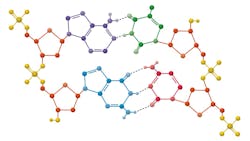Scientists have discovered a universal way of detecting amino acids that works for both humans and bacteria, according to a news release from Ohio State University.
The finding could lead to enhancements of drugs derived from the amino acid GABA, but also has evolutionary implications: It adds to the sparse evidence suggesting there are commonalities between bacteria and humans with respect to sensing the presence of essential components of life, such as oxygen and food.
Receptors on cell surfaces detect all kinds of nutrients — fats, sugars, and vitamins, for example — but use different types of protein segments called sensors, and no common chemical detection mechanism is currently known.
In this work, scientists discovered a universal sensor present in many different receptors that detects amino acids by precisely interacting with the two groups of atoms that are shared by all amino acids.
“In our experience, it’s very rare when we can extrapolate a very specific sensory function with such precision from bacteria to humans, because these life forms are separated by such a long evolutionary time — about 3 billion years,” said Igor Jouline, Professor of Microbiology at Ohio State university and a senior author of the study.
The study is published in Proceedings of the National Academy of Sciences.
Amino acids are the building blocks of life, assembling proteins, which perform most of the work inside cells, from the information stored in genes.
Before this study, drug developers knew that medications derived from GABA (gamma-aminobutyric acid), treating neuropathic pain, fibromyalgia, and seizures, relieve symptoms linked to these disorders by attaching to a protein in the human nervous system.
That protein, it turns out, is the one the research team found in humans that contains the motif enabling detection of amino acids, including GABA.
“Our work is not solving pharmacological problems, but it showed precisely where on the human protein GABA-derived drugs will bind, and also how they will bind,” Jouline said. “That’s important, because now if they want to improve it or test different versions of the drug, they know the exact chemical environment. We’re providing these two missing points — which part of the drug will bind to which amino acid of the protein, and how it’s oriented in 3D space.”

